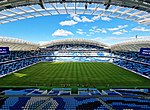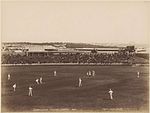Sydney Football Stadium (1988)

The Sydney Football Stadium, commercially known as Allianz Stadium and previously Aussie Stadium, was a football stadium in Moore Park, Sydney, Australia. Built in 1988 next to the Sydney Cricket Ground, the stadium was Sydney's premier rectangular field venue for rugby league, rugby union, and soccer. The Kangaroos, the Wallabies, and the Socceroos occasionally played at the stadium, while the Sydney Roosters, NSW Waratahs, and Sydney FC were the ground's major tenants. The stadium usually held both National Rugby League semi finals and one preliminary final, and also held the annual pre-season Charity Shield football match between South Sydney and St George Illawarra for a number of years. It hosted all New South Wales Rugby League/Australian Rugby League rugby league grand finals, as well as the first grand final under the NRL banner, between 1988 and 1998. The NSW Government announced plans in November 2017 for the stadium to be demolished and rebuilt. The stadium closed in October 2018, with the last event being a Michael Bublé concert. Demolition began in early 2019, continuing after several legal challenges and becoming a major issue during the 2019 state election. It was ultimately replaced by the Sydney Football Stadium (2022) opening on 28 August 2022.
Excerpt from the Wikipedia article Sydney Football Stadium (1988) (License: CC BY-SA 3.0, Authors, Images).Sydney Football Stadium (1988)
Moore Park Road, Sydney Paddington
Geographical coordinates (GPS) Address Nearby Places Show on map
Geographical coordinates (GPS)
| Latitude | Longitude |
|---|---|
| N -33.889166666667 ° | E 151.22527777778 ° |
Address
Allianz Stadium (Sydney Football Stadium)
Moore Park Road
2021 Sydney, Paddington
New South Wales, Australia
Open on Google Maps







